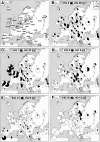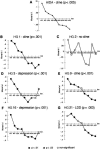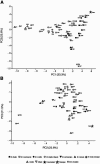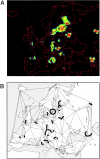Y-chromosomal diversity in Europe is clinal and influenced primarily by geography, rather than by language
- PMID: 11078479
- PMCID: PMC1287948
- DOI: 10.1086/316890
Y-chromosomal diversity in Europe is clinal and influenced primarily by geography, rather than by language
Abstract
Clinal patterns of autosomal genetic diversity within Europe have been interpreted in previous studies in terms of a Neolithic demic diffusion model for the spread of agriculture; in contrast, studies using mtDNA have traced many founding lineages to the Paleolithic and have not shown strongly clinal variation. We have used 11 human Y-chromosomal biallelic polymorphisms, defining 10 haplogroups, to analyze a sample of 3,616 Y chromosomes belonging to 47 European and circum-European populations. Patterns of geographic differentiation are highly nonrandom, and, when they are assessed using spatial autocorrelation analysis, they show significant clines for five of six haplogroups analyzed. Clines for two haplogroups, representing 45% of the chromosomes, are continentwide and consistent with the demic diffusion hypothesis. Clines for three other haplogroups each have different foci and are more regionally restricted and are likely to reflect distinct population movements, including one from north of the Black Sea. Principal-components analysis suggests that populations are related primarily on the basis of geography, rather than on the basis of linguistic affinity. This is confirmed in Mantel tests, which show a strong and highly significant partial correlation between genetics and geography but a low, nonsignificant partial correlation between genetics and language. Genetic-barrier analysis also indicates the primacy of geography in the shaping of patterns of variation. These patterns retain a strong signal of expansion from the Near East but also suggest that the demographic history of Europe has been complex and influenced by other major population movements, as well as by linguistic and geographic heterogeneities and the effects of drift.
Figures






Comment in
-
The peopling of Europe from the maternal and paternal perspectives.Am J Hum Genet. 2000 Dec;67(6):1376-81. doi: 10.1086/316917. Epub 2000 Nov 9. Am J Hum Genet. 2000. PMID: 11078473 Free PMC article. No abstract available.
References
Electronic-Database Information
-
- Molecular Genetics Laboratory of the McDonald Institute for Archaeological Research, http://www-mcdonald.arch.cam.ac.uk/Genetics/home.html
References
-
- Adams J, Otte M (1999) Did Indo-European languages spread before farming? Curr Anthropol 40:73–77
-
- Ammerman AJ, Cavalli-Sforza LL (1984) Neolithic transition and the genetics of populations in Europe. Princeton University Press, Princeton, NJ
-
- Barbujani G (1991) What do languages tell us about human microevolution? Trends Ecol Evol 6:151–156 - PubMed
-
- Barbujani G, Oden NL, Sokal RR (1989) Detecting regions of abrupt change in maps of biological variables. Syst Zool 38:376–389
Publication types
MeSH terms
Substances
Grants and funding
LinkOut - more resources
Full Text Sources

